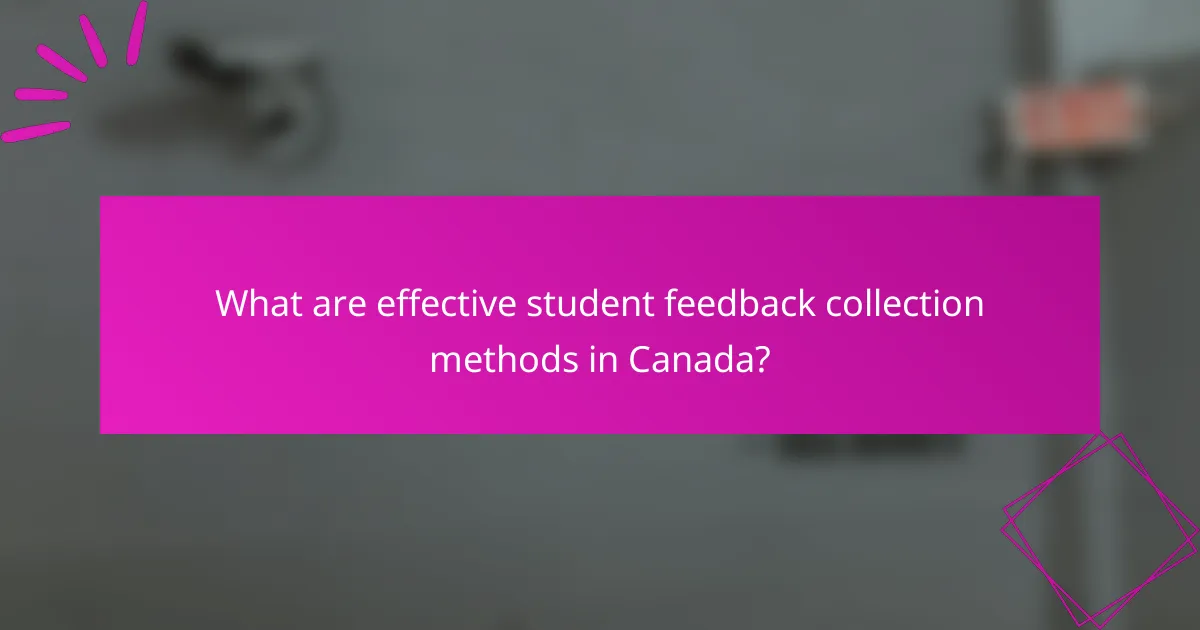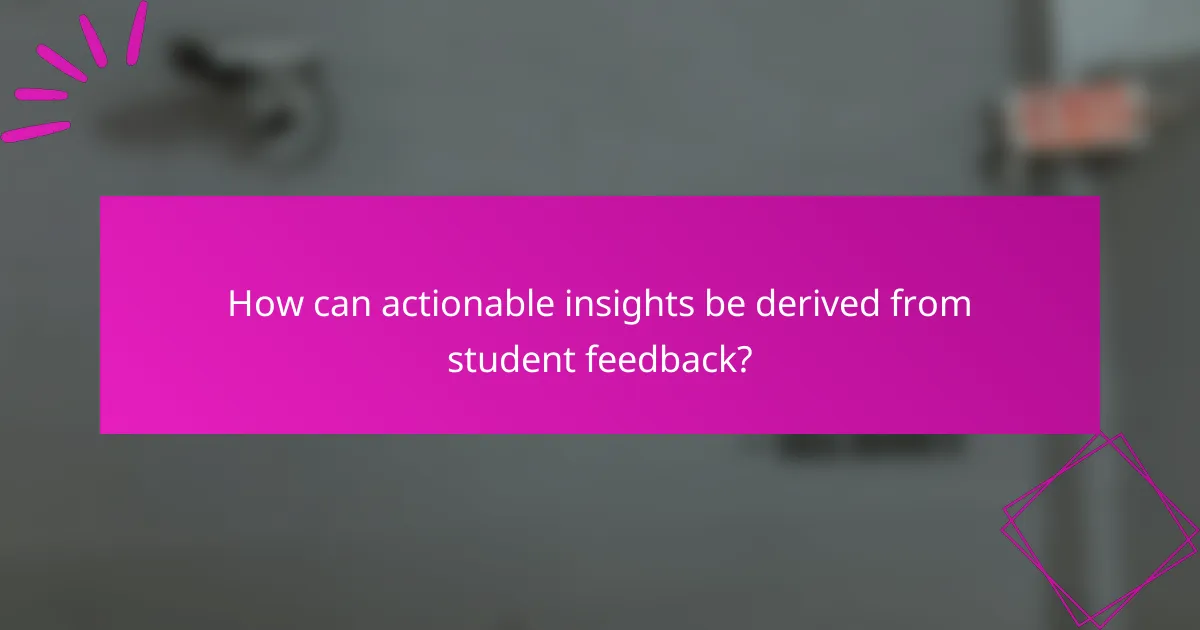Collecting student feedback is essential for enhancing educational experiences, and various methods can be employed to cater to diverse learning environments. By leveraging digital tools, educators can streamline the feedback process, improve response rates, and gain real-time insights. Analyzing this feedback through both qualitative and quantitative techniques allows for the extraction of actionable insights that can inform teaching practices and better meet student needs.

What are effective student feedback collection methods in Canada?
Effective student feedback collection methods in Canada include various approaches that cater to different learning environments and preferences. Utilizing a combination of these methods can enhance the quality and depth of feedback received from students.
Online surveys
Online surveys are a popular method for collecting student feedback due to their convenience and scalability. They can be distributed via email or learning management systems, allowing students to respond at their own pace. Consider using platforms like Google Forms or SurveyMonkey, which offer customizable templates and analytics tools.
When designing surveys, keep questions clear and concise, and include a mix of multiple-choice and open-ended questions to gather both quantitative and qualitative data. Aim for a completion time of under 10 minutes to encourage participation.
Focus groups
Focus groups involve small groups of students discussing their experiences and opinions about a specific topic. This method allows for in-depth exploration of feedback and can uncover insights that surveys may miss. Typically, a facilitator guides the discussion, ensuring all voices are heard.
To conduct effective focus groups, select a diverse group of participants and prepare open-ended questions in advance. Limit sessions to about 60-90 minutes to maintain engagement and focus.
Interviews
Interviews provide a one-on-one opportunity for students to share their feedback in a more personal setting. This method allows for deeper understanding as interviewers can probe for clarification and explore topics in greater detail. Consider scheduling interviews at times convenient for students to maximize participation.
Prepare a semi-structured format with key questions but remain flexible to follow the conversation where it leads. Aim for interviews lasting 20-30 minutes to ensure they are manageable for both parties.
Feedback apps
Feedback apps are increasingly popular in educational settings, allowing students to provide real-time feedback through mobile devices. These applications can facilitate quick responses to specific questions or overall course evaluations, making it easy for students to share their thoughts on the go.
Choose apps that are user-friendly and integrate well with existing systems. Encourage students to use these tools regularly to foster a culture of continuous feedback.
Classroom polls
Classroom polls are an effective way to gather immediate feedback during lessons. Tools like Kahoot or Poll Everywhere enable instructors to ask questions and receive responses in real-time, helping to gauge student understanding and engagement.
Keep polls short and focused on key concepts to maintain attention. Use the results to adjust teaching strategies on the fly, ensuring that student needs are met promptly.

How can digital tools enhance feedback collection?
Digital tools significantly improve feedback collection by streamlining the process, increasing response rates, and providing real-time analysis. They allow educators to gather insights efficiently, making it easier to adapt teaching methods based on student needs.
Learning management systems
Learning management systems (LMS) like Moodle or Canvas facilitate feedback collection through integrated survey features and discussion forums. These platforms enable educators to create and distribute surveys directly within the course environment, ensuring higher engagement from students.
When using an LMS, consider the timing of feedback requests. Asking for feedback shortly after a lesson or assignment can yield more accurate insights. Additionally, ensure anonymity to encourage honest responses.
Survey platforms like SurveyMonkey
Survey platforms such as SurveyMonkey offer customizable templates and analytics tools that help educators design effective feedback surveys. These platforms can reach a broader audience, allowing for feedback collection from multiple classes or even entire programs.
To maximize response rates, keep surveys concise and focused, ideally under 10 questions. Utilize a mix of question types, including multiple-choice and open-ended questions, to capture both quantitative and qualitative data.
Real-time feedback tools like Mentimeter
Real-time feedback tools like Mentimeter allow educators to gather instant responses during lectures or workshops. These tools can be used for polls, quizzes, and open-ended questions, making the feedback process interactive and engaging.
Incorporate real-time feedback to gauge student understanding on the spot. This immediate insight can inform teaching adjustments during the session. Ensure that the technology is user-friendly and accessible to all students to avoid technical barriers.

What analysis techniques can be applied to student feedback?
Several analysis techniques can effectively process student feedback, allowing educators to derive meaningful insights. These methods range from qualitative approaches that explore subjective opinions to quantitative techniques that focus on measurable data.
Qualitative analysis
Qualitative analysis involves examining open-ended feedback to understand students’ thoughts and feelings. This method often includes coding responses into themes or categories, which helps identify common issues or suggestions.
To conduct qualitative analysis, gather feedback from surveys or interviews and read through the responses carefully. Highlight recurring phrases or sentiments, and consider using software tools for more extensive data sets to streamline the coding process.
Quantitative analysis
Quantitative analysis focuses on numerical data derived from student feedback, such as ratings or scores. This technique allows educators to measure satisfaction levels or performance metrics statistically.
To implement quantitative analysis, use structured surveys with Likert scales or multiple-choice questions. Analyze the data using statistical methods to identify trends or areas needing improvement, ensuring that sample sizes are adequate for reliable results.
Thematic analysis
Thematic analysis is a specific qualitative method that identifies and analyzes patterns within feedback. It helps educators understand broader themes that emerge from student responses.
To perform thematic analysis, first familiarize yourself with the data set. Then, systematically code the data to identify themes, ensuring that you remain open to unexpected insights. This method is particularly useful for exploring complex issues that require deeper understanding.
Sentiment analysis
Sentiment analysis uses natural language processing to determine the emotional tone of student feedback. This technique can quickly assess whether the overall sentiment is positive, negative, or neutral.
To apply sentiment analysis, utilize software tools that can analyze text data from feedback forms or online platforms. This method is efficient for large volumes of feedback, providing a quick overview of student attitudes and helping prioritize areas for action.

How can actionable insights be derived from student feedback?
Actionable insights from student feedback can be obtained by systematically analyzing responses to identify patterns and trends. These insights help educators make informed decisions to enhance the learning experience and address areas needing improvement.
Identifying trends
To identify trends in student feedback, collect data through surveys, focus groups, or informal discussions. Look for recurring themes in comments and ratings, such as common concerns about course content or teaching methods.
Utilize qualitative analysis techniques, like coding responses, to categorize feedback. Quantitative methods, such as statistical analysis, can also highlight significant trends, helping prioritize issues based on frequency or severity.
Implementing changes
After identifying trends, the next step is implementing changes based on the feedback. Prioritize actionable items that can realistically be addressed within the academic term, such as modifying course materials or adjusting teaching strategies.
Engage faculty and staff in discussions about the feedback to foster a collaborative approach to improvement. Consider piloting changes in a few classes before a broader rollout to evaluate effectiveness and gather further feedback.
Communicating results
Communicating the results of student feedback and subsequent changes is crucial for transparency and trust. Share findings with students through newsletters, meetings, or online platforms, highlighting what changes will be made and why.
Encourage ongoing dialogue by inviting further feedback on the changes implemented. This not only shows students that their input is valued but also helps create a culture of continuous improvement within the educational environment.

What are the prerequisites for effective feedback analysis?
Effective feedback analysis requires a clear understanding of objectives and defined metrics. These prerequisites ensure that the feedback collected is relevant and can be accurately assessed for actionable insights.
Clear objectives
Establishing clear objectives is crucial for effective feedback analysis. Objectives should outline what you aim to achieve with the feedback, such as improving course content or enhancing student engagement. This clarity helps in formulating questions that are directly aligned with your goals.
For example, if the objective is to enhance student satisfaction, the feedback questions should focus on aspects like course delivery, resource availability, and instructor support. This targeted approach ensures that the analysis remains focused and relevant.
Defined metrics
Defined metrics provide a framework for evaluating feedback effectively. Metrics should be specific, measurable, and aligned with the established objectives. Common metrics include satisfaction scores, completion rates, and qualitative comments categorized by themes.
For instance, using a Likert scale (1-5) for satisfaction can help quantify student responses, while thematic analysis of open-ended feedback can reveal deeper insights. Regularly reviewing these metrics allows for timely adjustments to improve the educational experience.



